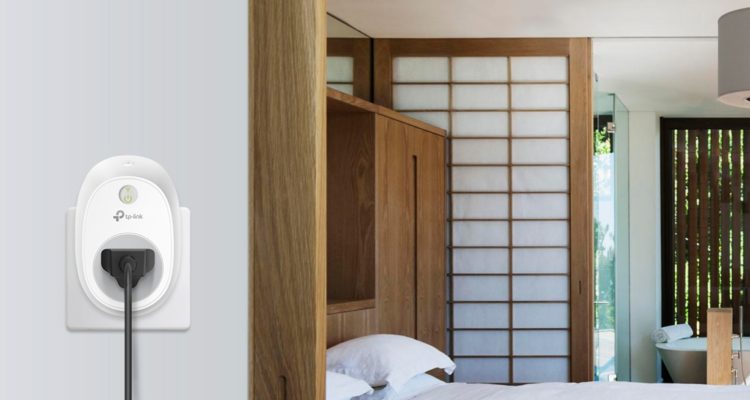A leader in wireless networking products, TP-Link has naturally drifted toward producing a line of smart home products over the past few years. Among their most popular devices is the TP-Link Smart Wi-Fi Plug (@ Amazon) which comes in a standard version (HS100) and one that provides energy monitoring (HS110). This simple device allows you to turn dumb items in your home into semi-smart ones that can be controlled remotely without a central hub.
We were not that impressed with the overall design of the TP-Link Smart Wi-Fi Plug. The front face is a dull white oval with a gray area around the plug. A button sits near top that has two small LEDs signalling that it’s connected to your home’s Wi-Fi and that the outlet is either on or off. The problem arises in how bulky the device is (note that TP-Link does now offer a mini version called the HS105). It comes out close to 3 inches from the wall and obstructs the other outlet. If it’s going to be that large, we’d prefer it going a bit further and offering two plugs to control. And to top it off, the LEDs on the device are always on. It’s not terribly bright but if you’re using this in a bedroom where you demand complete darkness, it can be annoying to see the little green light piercing through the room.
While the design left us shrugging our shoulders, the overall performance was much more uplifting. Setup requires installing TP-Link’s app named Kasa which is available on both Android and iOS. The app can be used for not just the smart plug but any smart home device sold by TP-Link. It walks you through connecting the device which requires first connecting your phone to the plug’s private network and then providing it with your Wi-Fi credentials. TP-Link is rather unique in that they allow you the option to setup the device only for local use if you want (say you just want to have it work as a sleep timer for a fan as you fall asleep). But for most of us, a smart plug’s benefit is in it’s ability to be controlled anywhere we can connect to the internet. For that, you’ll need to setup a cloud account with TP-Link which they’ll walk you through during the setup process. Overall the setup took around 15 minutes and did include us having to re-add the device when it didn’t connect properly the first time.
Once connected, the Kasa app was a delight to use. It was simple to setup names and even custom icons for the plug. For instance, if you’re using the plug for your Christmas lights, there is a little Christmas tree icon for that. And if you’ve got multiple TP-Link products, it lists them all with the on/off button next to it so you can manage everything on one screen. Features such as scheduling, away mode, and a sleep timer were prominently displayed and easy to configure. Giving the app permission for your location will even allow it to pinpoint sunrise and sunset for you automatically. For those with multiple TP-Link devices, you can get into setting up “scenes”. This allows you to configure scenarios where the devices work in tandem with one another. For instance you may want to set a “bedtime” scene that will shut off all the lights at once.
From a hardware standpoint, TP-Link Smart Plug held it’s own. Lag was non-existent turning on and off attached devices. The plug can handle up to 1800 watts and 15 amps of current. This is considerably more than budget options like the Geeni Energi allow. It also should be safe for use with a modern space heater or window air conditioner unit. When attached appliances are off, it only draws about 0.6 watts in its standby state. Firmware updates do seem to be happening on a regular basis which eases security concerns. Perhaps the only real miss is it not working with 802.11ac networks. This leaves you with 2.4GHz as your only option.
For those looking for voice control, the smart plug is compatible with both Amazon Alexa and Google Home. You’ll need to enable the skill with Amazon (search TP-Link Kasa) or add the device under the Home Control section on the Google Assistant. Both options require logging in with your TP-Link cloud account that you likely created during the installation. In our testing with both smart speakers, the plug connected and worked flawlessly. For IFTTT aficionados, Kasa is currently in beta stages of integration but looks promising. Unfortunately there is no Apple HomeKit support at the moment.
As we mentioned earlier, the TP-Link Smart Plug comes in two different models. The HS100 which is the standard smart plug and the HS110 which provides energy monitoring (and runs about $5 more). The only other difference is the HS110 comes in a fully white exterior. As for the energy monitoring, it worked fine in our testing. The data is fairly rudimentary and there unfortunately isn’t an option to export the data for use elsewhere. Unless you have a specific device that you really feel the need to monitor, we just don’t see the value in it.
Conclusion
The TP-Link Smart Wi-Fi Plug (HS100) works perfectly fine and is backed by a leader in wireless technology. It’s integration with both Amazon and Google provide voice controls and it’s Kasa app has a friendlier user interface than its counterparts. Unfortunately, it’s bulky design that blocks the adjacent outlet and beams a green light is a problem for us. We’d rather pay a few extra bucks for the TP-Link Kasa Smart Wi-Fi Plug Mini that has an updated design that only occupies one socket. But if socket space is not a concern for you and you’re on a tight budget, this is a perfectly acceptable smart plug to help begin your odyssey into home automation.
ASIN: B0178IC734
UPC: 797728955803




